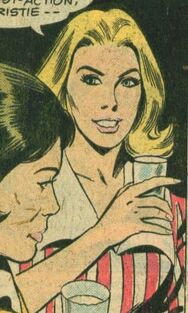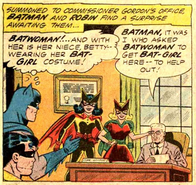- You may be looking for the Batgirl Disambiguation Page.
| SuperFriends Comic Book Character | |
| Bat-Girl | |
|---|---|

| |
| Information | |
| Real name: | Elizabeth Kane |
| AKA: | Betty Kane Bette Kane |
| Species: | Human |
| Homeworld: | Earth |
| Universe: | Earth-1A |
| Relatives: | Katherine Kane (aunt) |
| Occupation: | Crime Fighter |
| Base: | Gotham City |
| Affiliations: | Teen Titans West Batman Family |
Teen Titans 'West' Team Member

Bat-Girl in her first appearance from Batman, Vol. 1 #139 (April, 1961)

Betty Kane, from Teen Titans #50
Elizabeth Kane was the niece of a rich Gotham City’s socialite, Kathy Kane. Kathy secretly operated as the Batwoman of Gotham City, and an occasional ally of Batman and Robin. After discovering her aunt's dual identity, Betty convinced Batwoman to train her as her sidekick. Making her own costume, Betty would become Bat-Girl and undergo training alongside Kathy. Kathy hoped that her niece would soon lose interest; however, Betty would prove herself again and again.[1] During her adventures with Batwoman, Bat-Girl developed a romantic interest in Batman's sidekick Robin.
Background Information[]
In the parallel-universe of Earth-One, Bat-Girl would aid Batman, Robin, and Batwoman in combating villainy wherever it rose.[2]
Bat-Girl would try to show her affections for Robin and be rejected because Robin was committed to another woman. She was partially relieved to hear that the woman Robin was committed to being Lady Justice.[3]
When an alien from another dimension would come to Earth and threaten Gotham City, Batman, Batwoman, Robin, and Bat-Girl would attempt to stop the creatures. Robin and Bat-Girl would find themselves banished to the aliens' dimension. There, Bat-Girl would once more press Robin to share feelings with her, Robin would begin to warm up with her before they would return to Earth and help Batman and Batwoman turn away the invaders.[4] When a feud between Clayface and the Joker caused a series of crimes in Gotham City, Bat-Girl aided Batman, Robin, and Batwoman in capturing the Joker so that Batman could pose as him and capture Clayface.[5] When extraordinary circumstances find Batman turned into a genie and forced to do the bidding of two crooks, Robin and Bat-Girl would team-up to stop the crooks and free Batman.[6]
This would be Bat-Girl's last adventure with Batman and Robin for a number of years as she and her Aunt Kathy would retire from costumed adventuring for a time. Betty became a renowned tennis champ. During this period, Betty would meet her successor Barbara Gordon.[7]
She came out of retirement to aid the west coast incarnation of the Teen Titans and their east-coast counterparts (reuniting her with Robin) in battling Mr. Esper.[8]
Powers and Abilities[]
Abilities[]
- Hand-to-Hand Combat (Basic)
- Gadgetry
Appearances[]
Elizabeth did not appear in any episodes of the Superfriends.
Super Friends (comic book)[]
- Super Friends, Vol. 2 #3 (Feb. 1, 1977) -- Teen Titans Mentioned
- Super Friends, Vol. 2 #7 (Oct, 1, 1977) -- Robin is absent and is said to be busy helping the Titans.[9]
Gallery[]
Notes[]
- The original Bat-Girl first appeared in Batman #139 (April 1961).
- She was created by Bill Finger and Sheldon Moldoff.
- She first appeared as Betty Kane, the Bat-Girl. Her name was later modified to ‘Bette Kane’.
- Batwoman (in 1956) and Bat-Girl (in 1961) were created to be romantic interests for Batman and Robin, respectively and to refute the enduring claim that Batman and Robin were homosexuals.[10]
External Links[]
- See Elizabeth Kane (Earth One) at the DC Database
- See Elizabeth Kane at Wikipedia
References[]
- ↑ As revealed in Batman, #139/3 (April 1961).
- ↑ As revealed in Batman, #141/3 (August 1961).
- ↑ As revealed in Batman, #144/3 (December 1961).
- ↑ As revealed in Batman, #153 (February 1963).
- ↑ As revealed in Batman, #159 (November 1963).
- ↑ As revealed in Detective Comics, #322 (December 1963).
- ↑ As revealed in Batman Family, #16 (February/March 1978).
- ↑ As revealed in Teen Titans, #50; #51 and #52 (October - December 1977).
- ↑ The following issues are mentioned: Teen Titans, Vol. 1 #50 (October, 1977); Teen Titans, Vol. 1 #51 (December, 1977) and Teen Titans, Vol. 1 #52 (December, 1977).
- ↑ York, Christopher (2000). "All in the Family: Homophobia and Batman Comics in the 1950s". The International Journal of Comic Art. 2 (2): 100–110.




